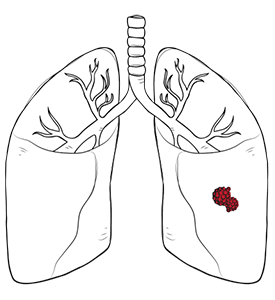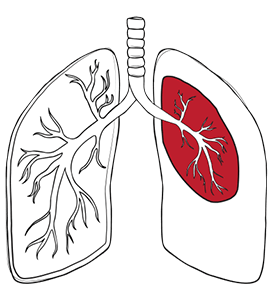

Pneumothorax is a complete or partial collapsed lung. It occurs when a blister in the lung (bullae) ruptures and causes air to leak out of the lung. The air then fills the space inside your chest, known as the pleural cavity. The air leaking out of the lung cannot escape and gets trapped between the chest wall and the lung, eventually increasing pressure on the lung and causing collapse.

Symptoms may include pneumothorax chest pain, shortness of breath, and difficult or rapid breathing. In severe cases, it can lead to respiratory failure and cardiovascular collapse, so timely pneumothorax diagnosis and treatment can be life-saving. The causes of pneumothorax vary significantly:
It’s important for a patient’s healthcare provider to recognise signs indicating an emergency requiring urgent care for patients to make a full recovery from this potentially serious condition.
In some cases, a minor pneumothorax may heal without medical intervention. However, larger amounts of air leakage and compression can be potentially life-threatening, particularly for individuals with underlying lung diseases like COPD or compromised respiratory function.
In severe cases, surgery may be required depending on how much air is present in the lungs before complications develop from prolonged exposure to low oxygen levels.
Diagnosis typically consists of imaging studies such as chest x-rays or low-dose computed tomography (CT) scans to confirm the presence and extent of any lung pneumothorax damage. With proper interventions based on an individualised assessment of severity and type, most people have favourable outcomes following pneumothorax diagnosis and treatment.
Minimally invasive techniques have become increasingly popular for pneumothorax interventions. At Neumark Lung & Chest Surgical Centre, our surgeons perform uniportal video-assisted thoracic surgery (U-VATS) to identify and remove the leaking blister (bullae), preventing further air leakage. U-VATS is safe and effective in treating primary spontaneous pneumothoraces and for the management of traumatic pneumothorax and recurrent cases.
A single port in the chest wall allows surgical instruments and camera access during U-VATS. The surgeon removes the blister (bullae) from the affected lung, thus treating air leakage from the lung. The surgeon will also perform a procedure to remove the chest wall lining or pleura, called pleurectomy, creating a rough inner surface of the chest wall. Once the lung is re-expanded, it comes in contact with the rough surface of the chest wall, forming adhesions to prevent a recurrent collapse of the lung if a pneumothorax were to recur.
Neumark’s thoracic specialist team, led by Dr Harish Mithiran, director and senior consultant thoracic surgeon at Gleneagles Hospital, is highly trained in the latest minimally invasive surgery for pneumothorax and manage other lung diseases and chest conditions. Our guiding principle combines personalised care coordination through sound clinical knowledge and groundbreaking treatments to achieve the best possible patient outcomes.
Pneumothorax may occur as a complication following chest tube removal. Air entering the pleural space during chest tube removal is especially common in patients with relatively thin, muscular chest wall anatomy. Even after successful thoracoscopic treatment, there is still a risk of recurrence due to poor healing or the formation of a new blister (bullae) in the lung.
Pneumothorax is when air accumulates between the lung and chest wall, causing the lung to collapse. This can be caused by trauma or underlying medical conditions such as COPD and can also occur spontaneously without any underlying disease. Increased air inside the chest cavity can cause an increase in pressure that pushes against the heart and lungs, reducing blood flow throughout your body. This is a sign of tension pneumothorax. It typically requires immediate medical attention as it can be life-threatening if left untreated.
The treatment for spontaneous pneumothorax can vary depending on the severity of the condition. In general, conservative treatment may be recommended for mild to moderate cases. At the same time, minimally-invasive interventions such as U-VATS may be prescribed if the air leak does not heal by itself and is prolonged, the pneumothorax recurs the second time, there is the presence of bilateral pneumothorax (pneumothorax occurring in both the lungs at the same time) and for professionals who are working as pilots, cabin crew staff and divers who are at a higher risk of pneumothorax recurrence due to pressure changes affecting their lungs during their work.
Secondary spontaneous pneumothorax occurs due to an underlying lung condition such as chronic obstructive pulmonary disease, cystic fibrosis, asthma or pneumonia. Air can leak from the lung into the chest wall, causing one side of the chest to collapse, leading to severe breathing difficulties. Treatment may involve inserting a tube to remove excess air from the pleural cavity and surgery to repair any damage.
Pneumothorax can occur after a transthoracic lung biopsy. Lung biopsies involve taking tissue samples from the lungs to identify any underlying medical conditions or other abnormalities. The dysfunction can happen when air escapes into the chest cavity during the procedure and causes the biopsied lung to collapse. The risk increases if the patient already has COPD or emphysema since these diseases weaken the lungs making them more likely to rupture during a biopsy.
A collapsed lung can be a complication of any chest cavity surgery. The condition is rare and usually only occurs in cases with underlying respiratory issues or complications with anaesthesia.
DISCLAIMER: The information provided on this website is for general informational purposes only and is not intended as a substitute for professional medical advice, diagnosis, or treatment. The use of this website does not create a doctor-patient relationship and no medical advice should be inferred or assumed. It is the user’s sole responsibility to seek the advice of their healthcare professionals for any medical concerns they may have and the user should not disregard, or delay, prompt medical advice for any such condition.
Neumark Lung and Chest Surgery Centre benefits from the expertise of a multidisciplinary team led by Dr Harish Mithiran, senior consulting thoracic surgeon at Gleneagles Hospital and Mt Alvernia Hospital.
Neumark is a lung and chest specialist centre with access to leading treatment modalities to achieve the best possible outcomes for lung disease and preventative patient screening.
Our foremost priority is to treat your condition as effectively as possible. Schedule a private consultation today; complete the form below, call, +65 6908 2145; WhatsApp, +65 9726 2485; or email, info@neumarksurgery.com.
Access the latest advice as well as full support throughout your treatment, and during after-care.
Learn how to refer a patient or to joining our physician network of leading providers in Singapore and abroad.
Main Surgery Centre
6 Napier Rd
#02-09 Gleneagles Medical Centre
Singapore 258499
820 Thomson Road
#06-07 Mount Alvernia Hospital Medical Centre A
Singapore 574623
Neumark Lung & Chest Surgery Centre benefits from the expertise of a multidisciplinary surgical team led by Dr Harish Mithiran, a senior consulting thoracic surgeon at Gleneagles Hospital.
With access to leading minimally-invasive treatment modalities for lung disease and chest conditions, our specialists in Singapore work to achieve the best possible outcomes for lung disease. Our foremost priority is to treat your condition as effectively as possible with world-class care.
6 Napier Road
#02-09 Gleneagles Medical Centre
Singapore 258499
820 Thomson Road
#06-07 Medical Centre A
Singapore 574623
© 2024 Neumark Lung & Chest Surgery Centre Pte. Ltd. | UEN 202136971R
Gleneagles Medical Centre
6 Napier Road
#02-09 Gleneagles Medical Centre
Singapore 258499
Mount Alvernia Hospital
820 Thomson Road
#06-07 Medical Centre A
Singapore 574623